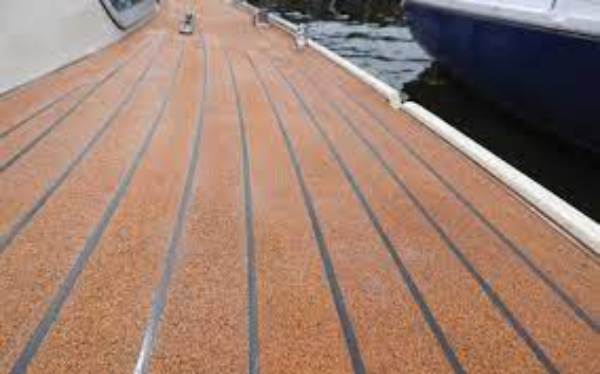Your lovely teak deck will eventually require cleaning, despite how durable teak wood is. While teak won’t rot, it can check, warp, and have a depressingly dull appearance if it isn’t properly maintained. Therefore, how do you clean teak wood on a boat? Discover how to properly clean the teak wood on your boat by reading this article.
How To Clean A Teak Deck On Your Boat
You’ll need the following equipment and supplies to clean your teak wood deck:
- rubber gloves and kneepads
- Sponge or foam brush.
- To clean the dirt from the teak, use a bronze wool pad or soft-bristled brushes.
- rags to rinse your teak after each scrub.
- a bucket filled with pure water for rinsing.
- For cleaning, use trisodium phosphate, or TSP. You can also use specialized teak cleaning products; we’ve listed a few below.
- Use blue painter’s tape to cover the teak where necessary.
- Optional: 120-grit sandpaper. If you need to remove the outdated finish from your deck, you will need sandpaper. On top of that, sanding can be used to repair any damage you unintentionally cause to your teak deck.
Purchase a sanding block and, for convenience, wrap the sandpaper around it. In addition, the block’s flat profile will distribute pressure uniformly.
- Additionally, you may get yourself a random orbital sander.
- Optional: whisk broom and dustpan to collect the remains of your old deck finish if you do end up sanding it. To remove the dust, you could also use a shop vac.
And this is how to clean a teak deck, step by step.
Prepare The Cleaning Solution
Get started by making your TSP cleaning solution. TSP ought to be accessible at boating supply shops.
Cleaning and degreasing teak decks with TSP is very effective. It’s reasonably priced and secure as well. Pour one gallon of water and two or three tablespoons of TSP into a bowl to create the cleaning solution.
Apply The Tsp Solution To The Deck
Apply the TSP mixture to the deck using a sponge. After about 5 minutes, rinse the wood and scrub it with a soft-bristled brush or a pad of bronze wool.
Your brush will begin to gather brown gunk; periodically rinse the brush in the bucket of water. Rinse the teak with a wet rag as well after collecting a significant amount of gunk.
Once you notice that very little gunk is coming out of the wood, keep scrubbing and rinsing. Go on to the following piece of wood after that.
When applying a cleaner to your deck, bear the following in mind:
- The solution shouldn’t be left on the deck for more than five minutes. The TSP may begin consuming the wood pulp if you leave it on the deck for any longer. Hard, unsightly lignin ridges will develop as a result of this.
- Be extremely cautious when using any acid-containing cleaner because it might eat away at the wood’s pulp.
- To avoid the solution remaining on the teak wood for longer than five minutes, you might need to apply the solution in small batches and then rinse it off.
- Bleach might be required for particularly difficult stains. However, bleach can easily damage the wood’s surface, so you should use it with extreme caution. Bleach should be used sparingly at first, and then more should be added if necessary.
- You could also purchase a teak brightener in place of bleach. Teak brighteners contain bleach, so use caution when using them as well.

Remove Lignin Ridges
You will need to sand the teak if the cleaner caused lignin ridges on the deck. The only option you have is this, which isn’t a perfect answer.
To sand the deck, you can use a random orbital sander and 120-grit sandpaper. You could also get a sanding block and some sandpaper. To be able to apply more consistent pressure to the wood, wrap the sandpaper around the sanding block.
Dust should be removed with a vacuum or a brush after sanding. Use a tack cloth to clean the surface as well.
Apply A Protective Coating To The Teak Deck
Applying a protective coating to the deck after it has been cleaned is recommended. You have two options:
- Teak oil. The natural golden hue of teak can be restored and preserved with teak oil. However, it doesn’t offer the best defense against moisture and sunlight.
- Teak sealer. Teak wood’s surface is shielded from the sun, salt, and moisture by teak sealers. Although sealers don’t make the wood look as good as oils do, they at least offer more security.
Both teak oil and sealer are acceptable, but you must first apply the oil.
If you’re interested, you should also take a look at our more detailed guide explaining the differences between teak oil and teak sealer.
It’s not a good idea to varnish teak decks, although some people might want to. You definitely do not want the varnish to become too slippery when it is wet.
How To Maintain Your Teak
When the final coat of finish is applied, your work is not finished. In order to keep the teak looking good, constant maintenance is necessary. When a boat is used in saltwater, frequent freshwater washdowns will definitely increase the lifespan of the covering.
Nevertheless, regular exposure to saltwater will probably make it lessen. The teak cockpit will require the most maintenance of all because of how busy it is. Even though they are simple to brush and retreat, sanding isn’t always preferred.
How Long Does A Teak Deck Last
Teak has a high level of durability and lasts for a very long time. A teak deck can last between 10 and 15 years if maintained properly. In some circumstances, you might even live past 20 years.
Having said that, a number of variables affect how long your teak deck will last. Primarily:
- How regularly do you keep your teak deck?
- original installation’s level of quality.
- how much do you use the deck?
Cleaning teak decks incorrectly may be the most harmful thing. Sanding and harsh cleaners can significantly shorten the deck surface’s lifespan and damage it.
Your deck will deteriorate over time, even if you take extreme precautions. Up to 1 mm of material can be lost from your deck every year due to sanding, cleaning, and contact with objects.
Teak decks range in thickness from 7 to 18 mm, so it doesn’t really take long to go through the entire piece of wood.



